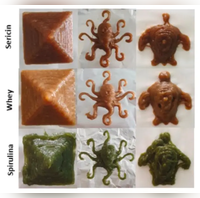KEY HIGHLIGHTS
- The team combined crickets, larvae, and a few other protein-rich insects with commonly-eaten vegetables like carrots. Their plan was to change the overall flavour and taste of the 'food'.
- According to Prof Chua Chee Kai, co-author from the Singapore University of Technology and Design (SUTD), people get uncomfortable with alternative sources of protein mainly due to their appearance. And that's where 3D printing comes in.
- Prof Yi Zhang, the principal investigator from UESTC, said their study can encourage more people around the world to try alternative sources of protein.
In Interstellar, visionary director Christopher Nolan gave us a dystopian plot, where astronauts and scientists were trying to find an inhabitable planet because Earth was running out of food.
On present earth, scientists are working on 3D printed food to overcome future supply issues. How about that?
What is the genesis of such a bizarre idea?
It's quite clear to everyone that the demand for protein-rich food is increasing every passing day as the global population continues to age and grow.
This demand has caused concerns about increasing land and water consumption for the conventional rearing of animals for good. Not to mention increasing greenhouse gases.
As protein-rich food cannot always be afforded by the poor, people in some parts of Africa, Asia, and South America have turned to alternative sources from plants, algae, and insects to get their nutrients.
But looking at the bigger picture, the idea of consuming algae and insects might still be an uncomfortable thing for the rest of the world.
That's why a team of Singapore-based researchers is now looking for ways to deal with the food supply problems. Recently, they came up with a way of making the idea of eating insects a little more palatable.
The team combined crickets, larvae, and a few other protein-rich insects with commonly-eaten vegetables like carrots. Their plan was to change the overall flavour and taste of the 'food'.
According to Prof Chua Chee Kai, co-author from the Singapore University of Technology and Design (SUTD), people get uncomfortable with alternative sources of protein mainly due to their appearance. And that's where 3D printing comes in.
“The appearance and taste of such alternative proteins can be disconcerting for many. This is where the versatility of 3D food printing rises to the challenge as it can transform the way in which food is presented and overcome the inertia of consumer inhibitions,” explained Prof Chua Chee Kai.
The 3D food printer creates a visually appealing dish of carrots and crickets that most people would at least be encouraged to try.
But there are challenges. The combination of food and their optimisation for 3D food printing is known to be a laborious task that is done using a trial and error-based approach, according to reports.
Prof Yi Zhang, the principal investigator from UESTC, said their study can encourage more people around the world to try alternative sources of protein.
Alternative proteins may become our main source of protein intake in the future. We hope our work would encourage consumers to eat more of these unfamiliar, but sustainable food items." he said.
Scientists are 3D printing food to encourage people to eat alternative sources of protein in future - Times Now
Read More


No comments:
Post a Comment